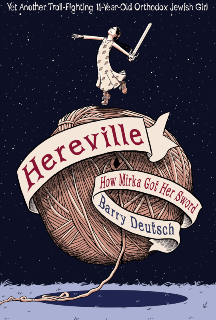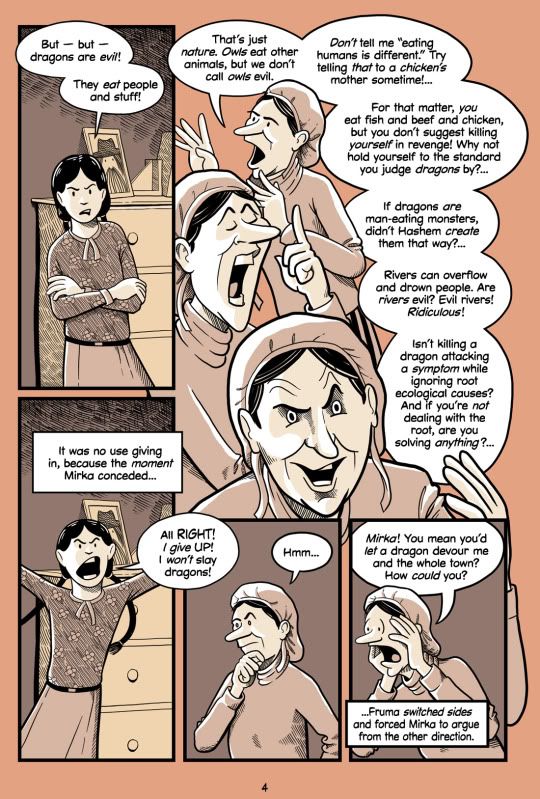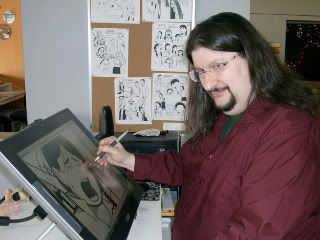In the Author’s Tent: Barry Deutsch
 True confession: I’ve never read a graphic novel before now. Never even been tempted. But after seeing Betsy Bird’s rave review (via School Library Journal), I asked author/illustrator Barry Deutsch if he would be willing to talk with me about HEREVILLE: How Mirka Got Her Sword. He said yes, and after exchanging several fun emails, he sent me an Advance Review Copy (ARC), which I devoured immediately–and enjoyed repeatedly.
True confession: I’ve never read a graphic novel before now. Never even been tempted. But after seeing Betsy Bird’s rave review (via School Library Journal), I asked author/illustrator Barry Deutsch if he would be willing to talk with me about HEREVILLE: How Mirka Got Her Sword. He said yes, and after exchanging several fun emails, he sent me an Advance Review Copy (ARC), which I devoured immediately–and enjoyed repeatedly.HEREVILLE is 100% fun for kids of all ages, and the author is equally delightful. Want to learn more about Barry and Mirka? Please join us in the Author’s Tent.
It’s an honor to have you here, Barry, and to help introduce HEREVILLE to an ever-widening circle of friends. Mazel tov on your book release, and kudos to you for the impressive collection of accolades it’s already garnered, including (this just in!) a starred review from Kirkus!
Thanks so much!
For those who haven’t yet heard about it, would you please give us a brief summary of HEREVILLE?
Hereville is the story of Mirka, an 11-year-old girl being raised in an extremely Orthodox Jewish community. But she dreams of fighting monsters and dragons and trolls, which isn’t very orthodox for an 11-year-old girl in that community! The story is about her family and her life, and also about the magical adventures she has. There’s knitting, and holidays, and siblings, and a witch, a troll, and an extremely grumpy pig.
After reading HEREVILLE many times over, I’m not so sure I’d limit its readership to a specific age group—would you?
I agree with you – Hereville can be enjoyed by folks of all ages. To be honest, I created Hereville with myself in mind as the audience. I was trying to do a fun adventure comic that I’d really enjoy as a reader. Then when my agent, Judy Hanson, sold it, it turned out it was a kid’s comic. Which is fine with me – I love a lot of kid’s comics.
I’m a big fan of Fruma, Mirka’s stepmother. What a character! I love that she tackles one side of an argument with gusto, and then….at the very moment her opponent seems to waver, she flips positions!

(All images copyrighted and posted with the author’s permission.)
So…enquiring minds my nine-year old friend Anna and I want to know: Who/What was your inspiration for her?
There’s a long tradition of fierce argumentation in Judaism. A great deal of the Talmud – the Talmud, for readers who don’t know, is one of the central texts of Judaism – consists of argumentation, in which the great rabbis and scholars would argue on all sides of many issues. So Fruma comes partly from that.
And Fruma comes partly from my own love of debate. I hold myself back a lot of the time, because people in real life find that sort of thing annoying, but I love argumentation, and am totally happy to switch sides just for the fun of it.
I have close family ties to the Jewish community, so I particularly enjoyed the cultural references in your book. Were they borne of outside research, or did they flow from the well stream of your own experiences?
It’s all research. I was raised in a very liberal Jewish home, nothing at all like the community Mirka lives in.
While Jewish orthodoxy is an important part of everyday life in HEREVILLE, it’s also knitted seamlessly into Mirka’s personal story. It feels fresh and effortless, so kudos for that! But perhaps you’d like to talk about the special challenges this entailed?
Thanks – I’m very glad you liked it, and that it didn’t seem labored to you.
The challenge arises mainly in being sincere. There’s a story I heard about a gospel singer who was asked if he believed the religious sentiments he was singing. The singer responded, “I believe while I’m singing.” I think cartooning works the same way. I don’t have the same beliefs as my characters, but I take their beliefs seriously, I respect them, and at some level, in order to make the scenes work correctly, I have to believe in those things a little myself, while I’m writing and drawing.
Which literary characters appealed most to your childhood self, and do they influence your reading/writing/drawing preferences even now?
I loved “Pogo,” Walt Kelly’s great comic strip, as a child, and in some ways he still influences me a lot. I also loved the “Great Brain” books by John D. Fitzgerald, and maybe there’s some Hereville influence there – in the fascination of making a very specific cultural setting come to life, and how seriously Fitzgerald took the voice and beliefs of his child narrator.
 Your bio page (on the HEREVILLE site) is fascinating! I’m intrigued by the pig collection in your drawing area, and admit to being a bit jealous of the enormous windows in front of your desk. That said, I’m wondering if your office layout has any influence on your creativity.
Your bio page (on the HEREVILLE site) is fascinating! I’m intrigued by the pig collection in your drawing area, and admit to being a bit jealous of the enormous windows in front of your desk. That said, I’m wondering if your office layout has any influence on your creativity.
Well, the toy pigs are important because they were my models while I was drawing Hereville!
I don’t think the office layout has a large influence on my work – at least not on the creative side. Having an office to go to does help a lot with my productivity, though.
What new things did you learn about yourself while writing HEREVILLE?
I learned that I could actually complete a long story. There had been so many incomplete, abandoned stories, that I had begun to wonder if I’d ever finish anything!
How do you go about creating a graphic novel? Do you write out the entire storyline first, and then illustrate the scenes and dialogue? Also, since HEREVILLE was originally a web comic, did you have to modify it in any way for print publication?
Hereville changed enormously between the webcomic and the graphic novel! When I began the webcomic, I was making up the story as I went along. But I also started doing research, and that let me make up more about Mirka’s life and Mirka’s community, and the more I knew, the more changes I needed to make.
As for how I create it, it’s all over the place. I had a story outline when I began the graphic novel, but major scenes were added to the story after I was already well into drawing. The scene were Fruma and Mirka discuss their dead mothers – which a friend of mine called the heart of the story – was also the last scene I added to the story. Some scenes I’d script completely, some I’d make up the script while laying out the pages. And then once I could see the layout, I’d have to modify the script, and then seeing the modified script would make me change the layout.
What tips or tools might you recommend to anyone thinking about writing/illustrating their own graphic novels?
For anyone starting out, I’d recommend not worrying about tools. Art Spiegelman drew Maus with ball-point pen on copy paper, and it’s one of the greatest comic books ever drawn. What’s important is producing pages. Ninety-nine percent of the time, if a just-starting-out creator has a problem, the problem isn’t what they draw with; it’s that they’re not producing lots and lots and lots of comic book pages. Until they do that, they won’t get good.
I imagine lots of creative souls will find comfort and encouragement in this answer! Practice and persistence…seems like good advice for everyone.
I know you’re busy working on the next graphic novel in the HEREVILLE series (yay!), so thanks for spending time with us today. But before we let you go…can I convince you to play the ever-popular LIGHTNING ROUND?
West Side Story or Into the Wild? West Side Story! (I’m a musical theater fanatic.)
Your favorite Crayola crayon color? Purple. I love purple.
GLEE or Dancing with the Stars? GLEE. (See above, re: musical theater fanatic.)
Betty or Veronica? Jughead.
Seafood or steak? Steak, please!
HEREVILLE is available from online retailers, or you can pick up a copy from your favorite independent bookseller. [Psst! I’ll let you in on a little gift-giving secret: You can also order a signed copy with a personalized sketch.]
Barry Deutsch attended Oberlin College, The School of Visual Arts in New York City (where he studied under comics legend Will Eisner), and finally graduated from Portland State University. While a student at PSU, Barry won the national Charles Schulz Award for best student cartoonist. He lives in Portland, Oregon, with eight housemates, three cats, dozens of tiny baby fish, and a number of small plastic pigs. Barry is currently working on a second Hereville graphic novel for Abrams. You can follow him on Twitter, Facebook, or his website. (Want to read more author interviews? Please visit the Author’s Tent archives.)
